In today’s world, where environmental concerns are becoming increasingly important, understanding eco-friendly construction how-to can greatly benefit both homeowners and real estate developers. With the rising demand for sustainable solutions, adopting environmentally friendly building methods is becoming a priority for many. This article aims to guide you through the essential aspects of eco-friendly construction, ensuring a brighter and more sustainable future.

The Importance of Eco-friendly Construction
The construction industry significantly impacts the environment, from high energy consumption to vast amounts of waste. Therefore, adopting eco-friendly construction practices is crucial in reducing the carbon footprint. Incorporating sustainable methods not only benefits the planet but also offers numerous advantages to homeowners and developers, such as reduced energy costs and increased property value.
Understanding the Basics of Eco-friendly Construction
1. What is Eco-friendly Construction?
Eco-friendly construction refers to building practices that prioritize environmental protection and sustainability. This involves utilizing renewable resources, efficient energy use, and waste reduction among other practices.
2. Benefits of Eco-friendly Construction
Some benefits include lower energy bills, increased property value, better indoor air quality, and reduced environmental impact. Understanding these advantages is essential for anyone interested in sustainable building practices.
Steps for Implementing Eco-friendly Construction
3. Planning and Designing for Sustainability
Proper planning and design are critical in ensuring a building’s sustainability. This entails choosing the right location, optimizing building orientation, and integrating energy-efficient systems. Explore our building planning tips to learn more.
4. Selecting Sustainable Materials
The choice of materials plays a significant role in eco-friendly construction. Opt for locally sourced, recycled, or renewable materials like bamboo, recycled steel, and reclaimed wood.
5. Incorporating Energy-efficient Systems
Energy efficiency is at the core of sustainable construction. Utilizing solar panels, geothermal heating, and LED lighting are effective ways to conserve energy.
6. Water Conservation Techniques
Water conservation is another critical element of eco-friendly building. Incorporate rainwater harvesting systems and low-flow fixtures to reduce water usage.
7. Waste Management Practices
Reducing, reusing, and recycling construction waste can significantly lessen environmental impact. Implementing a waste management plan is essential for sustainable projects.
8. Indoor Air Quality Improvements
Utilize materials and systems that enhance indoor air quality. This includes proper ventilation systems and using non-toxic paints and finishes.
Tools and Resources for Eco-friendly Construction
9. Certifications and Standards
Look for certifications like LEED and ENERGY STAR when planning your project. These standards ensure the building meets the criteria for sustainability and efficiency.
10. Government Incentives
Many governments offer incentives for adopting green building practices. Check with local authorities for grants or tax credits available for sustainable projects.
11. Choosing the Right Professionals
Selecting experienced and knowledgeable professionals in eco-friendly construction is vital. They can provide valuable insights and ensure the project adheres to sustainability standards.
Successful Eco-friendly Construction Case Studies
12. Real-world Examples
Explore some successful green building projects that demonstrate the benefits and potential of sustainable construction methods.
13. Lessons Learned and Insights
Gain insights from experts and previous projects to understand the best practices and common challenges faced in eco-friendly construction.
A Look at the Future of Eco-friendly Construction
14. Advancements in Sustainable Technology
Innovations in technology continue to drive eco-friendly building solutions forward. Stay informed about new tools and methods that promise even greater sustainability.
15. The Role of Community in Sustainable Building
Community involvement can play a significant role in the success of sustainable projects. Engaging with local stakeholders ensures projects meet community needs and expectations.

FAQs on Eco-friendly Construction How-To
What is the best way to start an eco-friendly construction project?
Begin with comprehensive planning and design that prioritizes sustainability. Engage professionals experienced in green building and utilize available resources and certifications.
How can I make my current home more eco-friendly?
Start with small changes, like installing energy-efficient appliances, using sustainable materials for renovations, and implementing water-saving measures.
Are eco-friendly buildings more expensive to construct?
While the initial cost may be higher, the long-term savings through reduced energy and water bills, along with increased property value, balance the initial investment.
For more insights on sustainable building practices, check out our best practices guide.
This article contains affiliate links. We may earn a commission at no extra cost to you.



